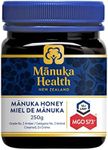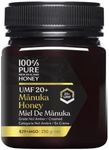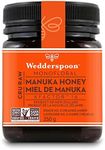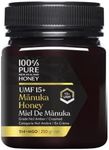Buying Guide for the Best Manuka Honey
Choosing the right manuka honey can be a bit overwhelming because of the different labels and numbers you might see on the jars. Manuka honey is prized for its unique properties and health benefits, but not all jars are created equal. To find the best fit for your needs, it's important to understand what the different ratings and characteristics mean, and how they relate to how you plan to use the honey—whether for general eating, as a natural remedy, or for skincare.UMF (Unique Manuka Factor)UMF is a grading system that measures the unique signature compounds found in manuka honey, such as methylglyoxal (MGO), leptosperin, and DHA. This rating is important because it indicates the honey's purity and potency. UMF values usually range from 5+ to 20+ or higher. Lower UMF (5+ to 9+) is suitable for everyday sweetening and general wellness, while higher UMF (10+ to 15+) is often chosen for more targeted health uses. The highest grades (16+ and above) are typically reserved for those seeking the strongest antibacterial properties, often for topical or medicinal purposes. To pick the right UMF, think about whether you want honey for daily use or for specific health reasons.
MGO (Methylglyoxal) ContentMGO is the compound responsible for manuka honey's antibacterial strength. The higher the MGO number, the more potent the honey. MGO values can range from around 100+ to over 800+. Lower MGO (100+ to 250+) is good for regular consumption, while mid-range (250+ to 500+) is better for those looking for extra health support. High MGO (500+ and above) is chosen for strong antibacterial needs, such as wound care or immune support. Your choice should depend on how strong you want the honey's effects to be.
Authenticity and CertificationAuthenticity is crucial because genuine manuka honey comes from New Zealand and is tested for its unique properties. Look for certification marks like UMF or MGO, and check for labels that mention independent testing or government approval. This ensures you're getting real manuka honey and not a blend or imitation. If you want the full benefits, always choose honey with clear certification.
Texture and TasteManuka honey can vary in texture from smooth and creamy to thick and grainy, and its taste ranges from mildly sweet to earthy and slightly bitter. These differences are mostly a matter of personal preference. If you plan to eat the honey straight or use it in recipes, you might prefer a smoother, milder honey. For topical use, texture is less important. Think about how you want to use the honey and choose a texture and flavor that suits your taste.
Packaging and StorageManuka honey is sensitive to light and heat, so it's usually sold in dark, sturdy jars. Good packaging helps preserve its quality and potency. If you plan to use the honey over a long period, look for jars that seal tightly and are easy to store. Proper storage will keep your honey fresh and effective for longer.















